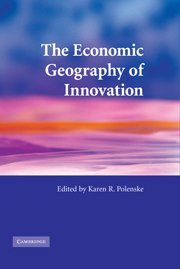Book contents
- Frontmatter
- Contents
- List of figures
- List of tables
- Notes on contributors
- Acknowledgments
- Abstracts
- List of abbreviations and acronyms
- Part I Concepts and measurements in innovation
- Part II Institutional and spatial aspects of information and knowledge flows
- Part III Institutions and innovation systems
- 10 National systems of production, innovation, and competence building
- 11 Perspectives on entrepreneurship and cluster formation: biotechnology in the US Capitol region
- 12 Facilitating enterprising places: the role of intermediaries in the United States and United Kingdom
- 13 Innovation, integration, and technology upgrading in contemporary Chinese industry
- 14 Society, community, and development: a tale of two regions
- Index
- References
10 - National systems of production, innovation, and competence building
Published online by Cambridge University Press: 22 September 2009
- Frontmatter
- Contents
- List of figures
- List of tables
- Notes on contributors
- Acknowledgments
- Abstracts
- List of abbreviations and acronyms
- Part I Concepts and measurements in innovation
- Part II Institutional and spatial aspects of information and knowledge flows
- Part III Institutions and innovation systems
- 10 National systems of production, innovation, and competence building
- 11 Perspectives on entrepreneurship and cluster formation: biotechnology in the US Capitol region
- 12 Facilitating enterprising places: the role of intermediaries in the United States and United Kingdom
- 13 Innovation, integration, and technology upgrading in contemporary Chinese industry
- 14 Society, community, and development: a tale of two regions
- Index
- References
Summary
Introduction
What follows is a shortened, and slightly revised, version of a paper published in Research Policy (Lundvall et al., 2002). In this introduction, We provide a few brief reflections on the innovation system concept in the light of economic geography. We make no attempt to give full justice to the literature on economic geography that predates the literature on innovation systems, however.
While the idea of a national system of innovation (NSI) attempts to explain and understand innovation in economic terms, the concept may also be seen as a combination of different elements – some of which emanate from economic geography and from the development literature. Perroux (1969) and Brookfield (1975), for instance, are among the common references. The overlap of ideas also has to do with timing. The NSI idea was shaped in the first half of the 1980s, and this was also a period of renewal of Marshallian economic geography related to regional studies that referred to industrial districts and clusters (Scott 2000: 29).
It is therefore not so surprising that currently the most advanced and frequent “users” of the concept of NSIs are to be found among economic geographers rather than among economists. This can be documented, for instance, by using the search machine, Google Scholar. Another factor is that economic geographers, for historical and epistemological reasons, are much less inhibited in their use of heterodox ideas emanating from bordering disciplines.
- Type
- Chapter
- Information
- The Economic Geography of Innovation , pp. 213 - 240Publisher: Cambridge University PressPrint publication year: 2007
References
- 3
- Cited by



